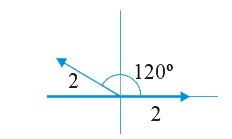(A): Electric current density is a vector
(R): A physical quantity having magnitude and direction should be always a vector.
Both (A) and (R) are true and (R) is the correct explanation of (A)
Both (A) and (R) are true and (R) is not the correct explanation of (A)
(A) is true but (R) is false
Both (A) and (R) are false
The correct Answer is:C
To solve the question, we need to analyze both statements provided:
Step 1: Analyze Statement A
- Statement A asserts that "Electric current density is a vector."
- Electric current density (denoted as J) is defined as the amount of electric current flowing per unit area. Mathematically, it can be expressed as:
J=IA
where I is the electric current and A is the area through which the current flows.
- Since electric current density has both magnitude (the amount of current per unit area) and direction (the direction of current flow), it is indeed a vector quantity.
- Therefore, Statement A is True.
Step 2: Analyze Statement R
- Statement R states that "A physical quantity having magnitude and direction should always be a vector."
- While it is true that vectors have both magnitude and direction, not all physical quantities that have magnitude and direction are vectors. For example, electric current has a magnitude (like 12 amperes) and a direction (the direction of flow), but it is not classified as a vector quantity.
- Thus, Statement R is False.
Step 3: Conclusion
- Based on the analysis:
- Statement A is True.
- Statement R is False.
- Therefore, the correct option is that A is true but R is false.
Final Answer:
The correct answer is: A is true but R is false.
---
- Statement A asserts that "Electric current density is a vector."
- Electric current density (denoted as J) is defined as the amount of electric current flowing per unit area. Mathematically, it can be expressed as:
J=IA
where I is the electric current and A is the area through which the current flows.
- Since electric current density has both magnitude (the amount of current per unit area) and direction (the direction of current flow), it is indeed a vector quantity.
- Therefore, Statement A is True.
- Statement R states that "A physical quantity having magnitude and direction should always be a vector."
- While it is true that vectors have both magnitude and direction, not all physical quantities that have magnitude and direction are vectors. For example, electric current has a magnitude (like 12 amperes) and a direction (the direction of flow), but it is not classified as a vector quantity.
- Thus, Statement R is False.
- Based on the analysis:
- Statement A is True.
- Statement R is False.
- Therefore, the correct option is that A is true but R is false.
The correct answer is: A is true but R is false.
Topper's Solved these Questions
- MOTION IN A PLANEBOOK - AAKASH SERIESCHAPTER - MOTION IN A PLANEEXERCISE - EXERCISE-IB (Addition and subtraction of vectors)
10 Videos
- MOTION IN A PLANEBOOK - AAKASH SERIESCHAPTER - MOTION IN A PLANEEXERCISE - EXERCISE-IB (Resolution of vectors )
1 Videos
- MOTION IN A PLANEBOOK - AAKASH SERIESCHAPTER - MOTION IN A PLANEEXERCISE - EXERCISE-A (Matching)
7 Videos
- MAGNETISMBOOK - AAKASH SERIESCHAPTER - MAGNETISMEXERCISE - ADDITIONAL EXERCISE
22 Videos
- MOTION IN A PLANEBOOK - AAKASH SERIESCHAPTER - MOTION IN A PLANEEXERCISE - QUESTION FOR DESCRIPTIVE ANSWER
7 Videos
Similar Questions
Knowledge Check
A vector quantity is :
AworkBpressureCdistanceDvelocity
A physical quantity which has a direction:-
View SolutionA physical quantity which has a direction:-
View SolutionFind the magnitude and direction of the resultant of given vectors

View SolutionElectric current has both magnitude and direction it is a .
View Solution(A): Electric Current and velocity of light both have direction as well as magnitude but still are not considered as vectors.
(R): They do not follow laws of vector addition.
View Solution→A is a vector of magnitude 2.7 units due east . What is the magnitude and direction of vector 4 →A ?
View SolutionIdeal cloning vector should have
View Solution
